See also
A Jupyter notebook version of this tutorial can be downloaded here.
Scope acquisition#
The QRM/QRM-RF instruments have high speed analog to digital capability for performing measurements. In this tutorial we will demonstrate the sequencer based scope acquisition procedure allowing you to inspect and process the raw input of the QRM-RF.
We will also have a look at how to average multiple scope acquisitions in hardware (see section Acquisition). We will show this by using a QRM-RF and directly connecting outputs \(\text{O}^{[1-2]}\) to inputs \(\text{I}^{[1-2]}\) respectively. We will then use the QRM-RF sequencers to sequence waveforms on the outputs and simultaneously acquire the resulting waveforms on
the inputs. As this tutorial uses waveform generation and acquisition, it will cover usage of waveforms and acquisitions in the sequence.
As with all operations with QxM instruments, the devices will be controlled by preparing and uploading sequences onto the Q1 processors. For more info on the features, programming and operation of Q1 sequence processor please view Q1 Sequencer.
Setup#
First, we are going to import the required packages.
[1]:
from __future__ import annotations
import json
from typing import TYPE_CHECKING, Callable
import matplotlib.pyplot as plt
import numpy as np
import scipy.signal
from qcodes.instrument import find_or_create_instrument
from qblox_instruments import Cluster, ClusterType
if TYPE_CHECKING:
from qblox_instruments.qcodes_drivers.module import QcmQrm
Scan For Clusters#
We scan for the available devices connected via ethernet using the Plug & Play functionality of the Qblox Instruments package (see Plug & Play for more info).
[2]:
!qblox-pnp list
Devices:
- 10.10.200.13 via 192.168.207.146/24 (reconfiguration needed!): cluster_mm 0.6.2 with name "QSE_1" and serial number 00015_2321_005
- 10.10.200.42 via 192.168.207.146/24 (reconfiguration needed!): cluster_mm 0.7.0 with name "QAE-I" and serial number 00015_2321_004
- 10.10.200.43 via 192.168.207.146/24 (reconfiguration needed!): cluster_mm 0.6.2 with name "QAE-2" and serial number 00015_2206_003
- 10.10.200.50 via 192.168.207.146/24 (reconfiguration needed!): cluster_mm 0.7.0 with name "cluster-mm" and serial number 00015_2219_003
- 10.10.200.53 via 192.168.207.146/24 (reconfiguration needed!): cluster_mm 0.7.0 with name "cluster-mm" and serial number 00015_2320_004
- 10.10.200.70 via 192.168.207.146/24 (reconfiguration needed!): cluster_mm 0.6.1 with name "cluster-mm" and serial number 123-456-789
- 10.10.200.80 via 192.168.207.146/24 (reconfiguration needed!): cluster_mm 0.6.1 with name "cluster-mm" and serial number not_valid
[3]:
cluster_ip = "10.10.200.42"
cluster_name = "cluster0"
Connect to Cluster#
We now make a connection with the Cluster.
[4]:
cluster = find_or_create_instrument(
Cluster,
recreate=True,
name=cluster_name,
identifier=cluster_ip,
dummy_cfg=(
{
2: ClusterType.CLUSTER_QCM,
4: ClusterType.CLUSTER_QRM,
6: ClusterType.CLUSTER_QCM_RF,
8: ClusterType.CLUSTER_QRM_RF,
}
if cluster_ip is None
else None
),
)
Get connected modules#
[5]:
def get_connected_modules(cluster: Cluster, filter_fn: Callable | None = None) -> dict[int, QcmQrm]:
def checked_filter_fn(mod: ClusterType) -> bool:
if filter_fn is not None:
return filter_fn(mod)
return True
return {
mod.slot_idx: mod for mod in cluster.modules if mod.present() and checked_filter_fn(mod)
}
[6]:
# QRM RF modules
modules = get_connected_modules(cluster, lambda mod: mod.is_qrm_type and mod.is_rf_type)
modules
[6]:
{8: <Module: cluster0_module8 of Cluster: cluster0>}
[7]:
readout_module = modules[8]
Generate waveforms#
Next, we need to create the gaussian and block waveforms for the sequence.
[8]:
# Waveform parameters
waveform_length = 120 # nanoseconds
# Waveform dictionary (data will hold the samples and index will be used to select the waveforms in the instrument).
waveforms = {
"gaussian": {
"data": scipy.signal.windows.gaussian(waveform_length, std=0.12 * waveform_length).tolist(),
"index": 0,
}
}
Let’s plot the waveforms to see what we have created.
[9]:
time = np.arange(0, max(map(lambda d: len(d["data"]), waveforms.values())), 1)
fig, ax = plt.subplots(1, 1, figsize=(10, 10 / 1.61))
for wf, d in waveforms.items():
ax.plot(time[: len(d["data"])], d["data"], ".-", linewidth=0.5, label=wf)
ax.legend(loc=4)
ax.grid(alpha=1 / 10)
ax.set_ylabel("Waveform primitive amplitude", fontsize=20)
ax.set_xlabel("Time (ns)", fontsize=20)
plt.draw()
plt.show()
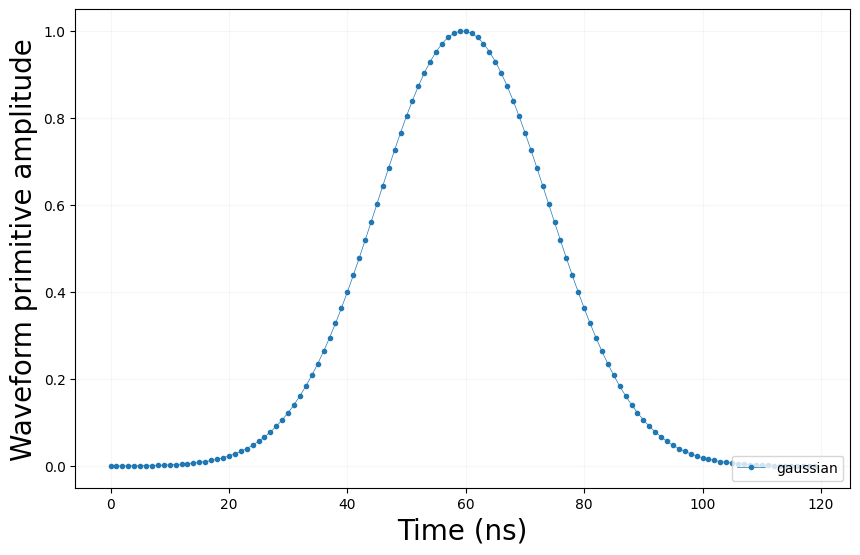
Specify acquisitions#
We also need to specify the acquisitions so that the instrument can allocate the required memory for it’s acquisition list. In this case we will create 5 acquisition specifications that each create a single bin. However, we will not be using the bins in this tutorial.
[10]:
# Acquisitions
acquisitions = {
"single": {"num_bins": 1, "index": 0},
"multiple_0": {"num_bins": 1, "index": 1},
"multiple_1": {"num_bins": 1, "index": 2},
"multiple_2": {"num_bins": 1, "index": 3},
"avg": {"num_bins": 1, "index": 4},
}
Create Q1ASM program#
Now that we have the waveforms and acquisitions specification for the sequence, we need a simple Q1ASM program that sequences and acquires the waveforms. For a reference of available commands with Q1ASM please visit Q1 Sequencer. Note how the Q1ASM references the JSON structures stored in the JSON file
[11]:
# Sequence program.
seq_prog = """
play 0,0,4 #Play waveforms and wait 4ns. Parameters: waveform index (from dict) on path 0, waveform index (from dict) on path 1, wait (in ns)
acquire 0,0,500 #Acquire waveforms and wait remaining duration of scope acquisition. Parameters: acquisition index (from dict), data bin, Duration of acq (in ns)
stop #Stop.
"""
Create and Upload sequence#
Now that we have the waveform and acquisition specifications and Q1ASM program, we can combine them in a sequence stored in a JSON file.
[12]:
# Add sequence to single dictionary and write to JSON file.
sequence = {
"waveforms": waveforms,
"weights": {},
"acquisitions": acquisitions,
"program": seq_prog,
}
with open("sequence.json", "w", encoding="utf-8") as file:
json.dump(sequence, file, indent=4)
file.close()
Let’s write the JSON file to the instruments. We will use sequencer 0, which will drive outputs \(\text{O}^{[1-2]}\) and acquire on inputs \(\text{I}^{[1-2]}\).
[13]:
# Upload sequence.
readout_module.sequencer0.sequence("sequence.json")
Play sequence#
The sequence has been uploaded to the instrument. Now we need to configure the sequencers to trigger the acquisition with the acquire instruction. As this is an RF module, there is a switch directly before the output connector which needs to be turned on to get a signal out of the device. The switch is controlled through the marker interface, which we use the override enable command and use appropriate bit to enable the output.
Additionally we configure the sequencer, the acquisition and the NCO frequency.
It should be noted that we expect a different outcome form the baseband modules from the acquisitions. For an NCO frequency of 0 MHz the acquired waveforms, will be slightly distorted as the RF modules contain high pass filters on the two paths. See the plotted waveforms below.
[14]:
readout_module.disconnect_outputs()
readout_module.disconnect_inputs()
# # Map sequencer to specific outputs (but first disable all sequencer connections)
readout_module.disconnect_outputs()
readout_module.disconnect_inputs()
# Set the LO frequency. If this is commented out, the value is set to the default value
readout_module.out0_in0_lo_freq(3e9)
readout_module.sequencer0.connect_sequencer("io0")
readout_module.sequencer0.marker_ovr_en(True)
readout_module.sequencer0.marker_ovr_value(3)
# Configure the sequencer to trigger the scope acquisition.
readout_module.scope_acq_sequencer_select(0)
readout_module.scope_acq_trigger_mode_path0("sequencer")
readout_module.scope_acq_trigger_mode_path1("sequencer")
readout_module.out0_offset_path0(0.5)
readout_module.out0_offset_path1(0.5)
# Configure the sequencer
readout_module.sequencer0.mod_en_awg(True)
readout_module.sequencer0.demod_en_acq(True)
readout_module.sequencer0.integration_length_acq(1024)
readout_module.sequencer0.nco_freq(100e6)
readout_module.sequencer0.sync_en(True)
# NCO delay compensation
readout_module.sequencer0.nco_prop_delay_comp_en(True)
Now let’s start the sequence.
[15]:
# Arm and start sequencer.
readout_module.arm_sequencer(0)
readout_module.start_sequencer()
sequencer_state = readout_module.get_sequencer_status(0)
# Print status of sequencer.
print("Status:")
print(sequencer_state)
Status:
Status: STOPPED, Flags: ACQ_SCOPE_DONE_PATH_0, ACQ_SCOPE_DONE_PATH_1, ACQ_BINNING_DONE
c:\work\code\qblox_instruments_install\qblox_instruments\native\generic_func.py:2414: FutureWarning:
After June 2024, this feature is subject to removal in future releases.
Transition to an alternative is advised.
See https://qblox-qblox-instruments.readthedocs-hosted.com/en/main/getting_started/deprecated.html
warnings.warn(
c:\work\code\qblox_instruments_install\qblox_instruments\native\generic_func.py:85: FutureWarning:
After June 2024, this feature is subject to removal in future releases.
Transition to an alternative is advised.
See https://qblox-qblox-instruments.readthedocs-hosted.com/en/main/getting_started/deprecated.html
self._deprecation_warning()
c:\work\code\qblox_instruments_install\qblox_instruments\native\generic_func.py:77: FutureWarning:
After June 2024, this feature is subject to removal in future releases.
Transition to an alternative is advised.
See https://qblox-qblox-instruments.readthedocs-hosted.com/en/main/getting_started/deprecated.html
self._deprecation_warning()
c:\work\code\qblox_instruments_install\qblox_instruments\native\generic_func.py:129: FutureWarning:
After June 2024, this feature is subject to removal in future releases.
Transition to an alternative is advised.
See https://qblox-qblox-instruments.readthedocs-hosted.com/en/main/getting_started/deprecated.html
self._deprecation_warning()
Retrieve acquisition#
The waveforms have now been sequenced on the outputs and acquired on the inputs. Lets make sure that the sequencer has finished it’s acquisition and then retrieve the resulting data. The acquisition data is stored in a temporary memory in the instrument’s FPGA. We need to first move the data from this memory into the into the instrument’s acquisition list. From there we can retrieve it from the instrument.
[16]:
# Wait for the acquisition to finish with a timeout period of one minute.
readout_module.get_acquisition_status(0, timeout=1)
# Move acquisition data from temporary memory to acquisition list.
readout_module.store_scope_acquisition(0, "single")
# Get acquisition list from instrument.
single_acq = readout_module.get_acquisitions(0)["single"]
c:\work\code\qblox_instruments_install\qblox_instruments\native\generic_func.py:3210: FutureWarning:
After June 2024, this feature is subject to removal in future releases.
Transition to an alternative is advised.
See https://qblox-qblox-instruments.readthedocs-hosted.com/en/main/getting_started/deprecated.html
warnings.warn(
Let’s plot the result.
[17]:
# Plot acquired signal on both inputs.
path0 = np.array(single_acq["acquisition"]["scope"]["path0"]["data"][130:300])
path1 = np.array(single_acq["acquisition"]["scope"]["path1"]["data"][130:300])
fig, ax = plt.subplots(1, 1, figsize=(15, 15 / 2 / 1.61))
ax.plot(path0)
ax.plot(path1)
ax.set_xlabel("Time (ns)", fontsize=20)
ax.set_ylabel("Relative amplitude", fontsize=20)
plt.show()
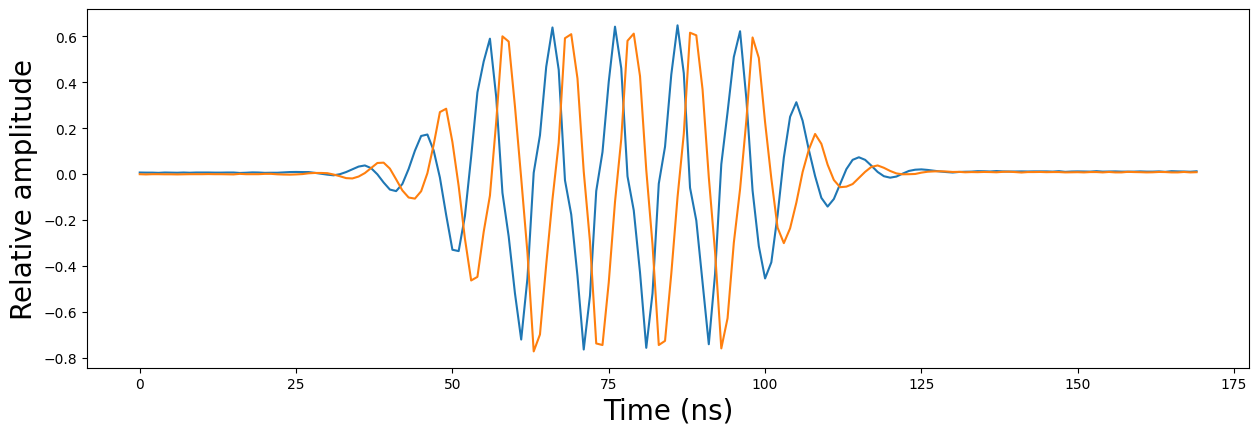
No Demodulation on Scope Acquisition#
The acquired signal from a scope acquisition is not demodulated. This means the modification the NCO perform to the two AWG paths do not get demodulated. As a result the acquired signal is the admixture of the two awg paths multiplied by a plane wave with the NCO frequency. (see Numerically Controlled Oscillator tutorial)
For an NCO freqeuncy of 0 Hz, this means we can retrieve the waveform shape that we send. In our case, this is a sine and a gaussian. However, for a non-zero NCO frequency we will see the modulated wave, composed of the pulse shape and a plane wave with the NCO frequency. Below is an example of the waveform one would see for a NCO frequency of 100 MHz. For this, we reconfigure the sequencer and acquire another scope trace.
[18]:
# Configure the sequencer
readout_module.sequencer0.mod_en_awg(True)
readout_module.sequencer0.demod_en_acq(True)
readout_module.sequencer0.integration_length_acq(1024)
readout_module.sequencer0.nco_freq(100e6)
readout_module.sequencer0.sync_en(True)
# NCO delay compensation
readout_module.sequencer0.nco_prop_delay_comp_en(True)
Start the sequencer again.
[19]:
# Arm and start sequencer.
readout_module.arm_sequencer(0)
readout_module.start_sequencer()
sequencer_state = readout_module.get_sequencer_status(0)
# Print status of sequencer.
print("Status:")
print(sequencer_state)
Status:
Status: STOPPED, Flags: ACQ_SCOPE_DONE_PATH_0, ACQ_SCOPE_DONE_PATH_1, ACQ_BINNING_DONE
Retrieve acquisition again.
[20]:
readout_module.get_acquisition_status(0, timeout=1)
# Move acquisition data from temporary memory to acquisition list.
readout_module.store_scope_acquisition(0, "single")
# Get acquisition list from instrument.
single_acq = readout_module.get_acquisitions(0)["single"]
[21]:
# Plot acquired signal on both inputs.
path0 = np.array(single_acq["acquisition"]["scope"]["path0"]["data"][130:300])
path1 = np.array(single_acq["acquisition"]["scope"]["path1"]["data"][130:300])
fig, ax = plt.subplots(1, 1, figsize=(15, 15 / 2 / 1.61))
ax.plot(single_acq["acquisition"]["scope"]["path0"]["data"][130:300])
ax.plot(single_acq["acquisition"]["scope"]["path1"]["data"][130:300])
ax.set_xlabel("Time (ns)", fontsize=20)
ax.set_ylabel("Relative amplitude", fontsize=20)
plt.show()
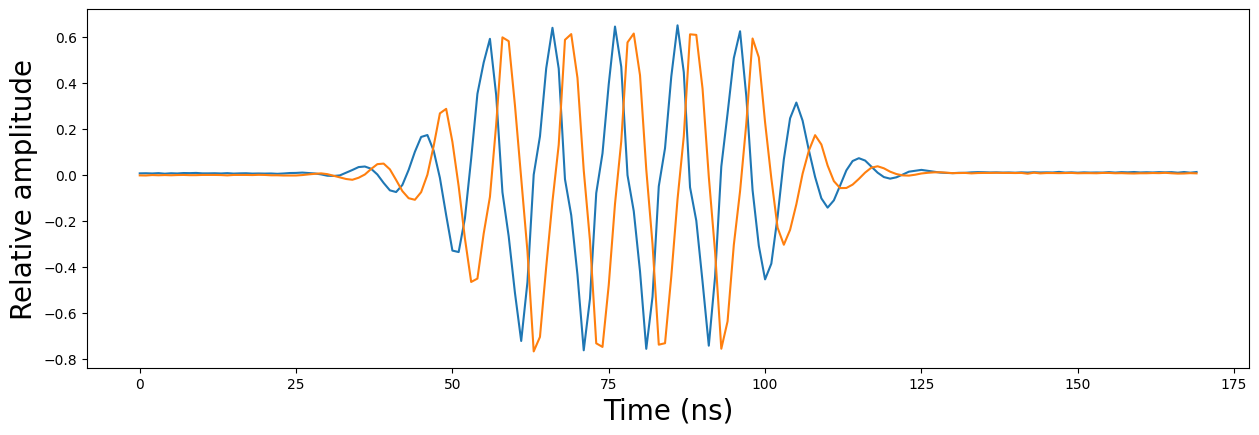
The demodulate waveform (the envelope) can be retrieved by taking the square modulus of both paths of the input.
[22]:
demod_wave = np.sqrt(path1**2 + path0**2)
# We plot all three waveforms together.
fig, ax = plt.subplots(1, 1, figsize=(15, 15 / 2 / 1.61))
ax.plot(path0)
ax.plot(path1)
ax.plot(demod_wave)
ax.set_xlabel("Time (ns)", fontsize=20)
ax.set_ylabel("Relative amplitude", fontsize=20)
plt.show()
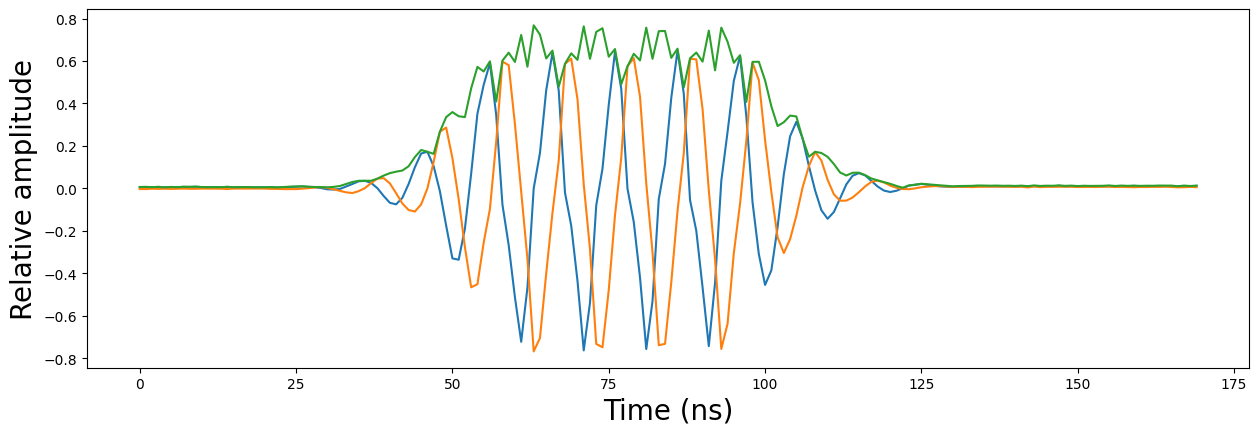
Retrieve multiple acquisitions#
We can also run the sequence multiple times consecutively and store the acquisition data in the instrument’s acquisition list before retrieving them all in one go. To demonstrate this we will run the same sequence three times and vary the output gain for each run to create a clear distinction between the acquisitions.
[23]:
# First run
readout_module.sequencer0.gain_awg_path0(0.33)
readout_module.sequencer0.gain_awg_path1(0.33)
readout_module.arm_sequencer(0)
readout_module.start_sequencer()
readout_module.get_acquisition_status(0, 1)
readout_module.store_scope_acquisition(0, "multiple_0")
# Second run
readout_module.sequencer0.gain_awg_path0(0.66)
readout_module.sequencer0.gain_awg_path1(0.66)
readout_module.arm_sequencer(0)
readout_module.start_sequencer()
readout_module.get_acquisition_status(0, 1)
readout_module.store_scope_acquisition(0, "multiple_1")
# Third run
readout_module.sequencer0.gain_awg_path0(1)
readout_module.sequencer0.gain_awg_path1(1)
readout_module.arm_sequencer(0)
readout_module.start_sequencer()
readout_module.get_acquisition_status(0, 1)
readout_module.store_scope_acquisition(0, "multiple_2")
# Get acquisition list from instrument.
multiple_acq = readout_module.get_acquisitions(0)
Let’s plot the result again.
[24]:
# Plot acquired signals (add acquisition index to separate acquisitions in plot).
fig, ax = plt.subplots(1, 1, figsize=(15, 15 / 1.61))
for acq_idx in range(0, 3):
ax.plot(
np.array(
multiple_acq[f"multiple_{acq_idx}"]["acquisition"]["scope"]["path0"]["data"][130:290]
)
+ acq_idx
)
ax.plot(
np.array(
multiple_acq[f"multiple_{acq_idx}"]["acquisition"]["scope"]["path1"]["data"][130:290]
)
+ acq_idx
)
ax.set_xlabel("Time (ns)", fontsize=20)
ax.set_ylabel("Relative amplitude", fontsize=20)
plt.show()
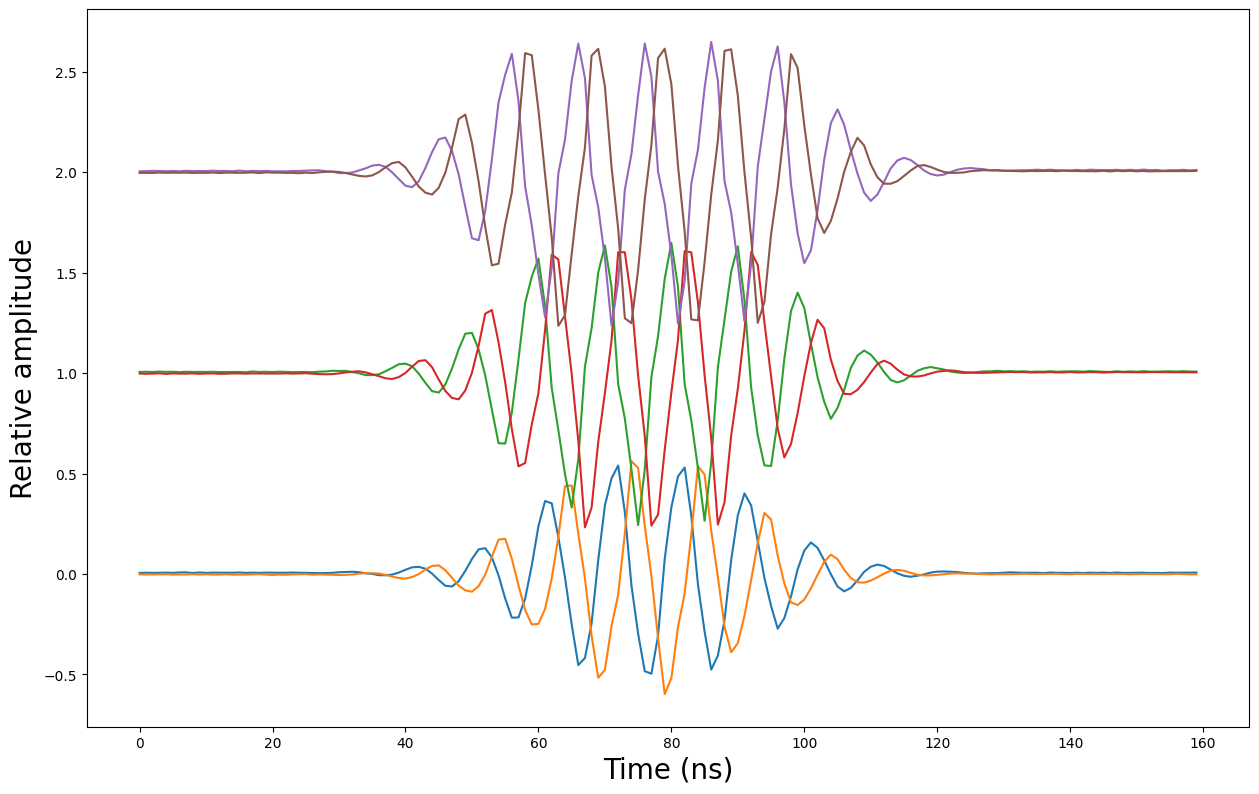
Hardware-based averaging#
We can also use hardware in the instrument itself to automatically accumulate acquisition data on-the-fly. This can be used to do averaging, by dividing the final accumulated result by the number of accumulations. To use this feature, we first need to modify the Q1ASM program to run the sequence multiple consecutive times.
[25]:
# Sequence program.
seq_prog = """
move 1000,R0 #Loop iterator.
loop: play 0,0,4 #Play waveforms and wait 4ns.
acquire 4,0,2000 #Acquire waveforms and wait remaining duration of scope acquisition.
loop R0,@loop #Run until number of iterations is done.
stop #Stop.
"""
Next, we need to program, configure and start the sequencer with the updated Q1ASM program. This time we will also configure the sequencer to run in averaging mode.
[26]:
# Add sequence to single dictionary and write to JSON file.
sequence = {
"waveforms": waveforms,
"weights": {},
"acquisitions": acquisitions,
"program": seq_prog,
}
with open("avg_sequence.json", "w", encoding="utf-8") as file:
json.dump(sequence, file, indent=4)
file.close()
# Upload sequence.
readout_module.sequencer0.sequence("avg_sequence.json")
# Enable hardware averaging
readout_module.scope_acq_avg_mode_en_path0(True)
readout_module.scope_acq_avg_mode_en_path1(True)
# Arm and start sequencer.
readout_module.arm_sequencer(0)
readout_module.start_sequencer()
# Wait for sequence and acquisitions to finish.
readout_module.get_acquisition_status(0, 1)
# Move accumulated result from temporary memory to the instrument's acquisition list.
readout_module.store_scope_acquisition(0, "avg")
# Get acquisition list from instrument.
avg_acq = readout_module.get_acquisitions(0)
The sequence has now run and accumulated a 1000 times. Time to finish the averaging process and print the result. Here we have also plotted the square modulus of the two paths.
[27]:
# Plot results.
fig, ax = plt.subplots(1, 1, figsize=(15, 15 / 2 / 1.61))
path0_av = np.array(avg_acq["avg"]["acquisition"]["scope"]["path0"]["data"][130:290])
path1_av = np.array(avg_acq["avg"]["acquisition"]["scope"]["path1"]["data"][130:290])
av_mod_sq = np.sqrt(path0_av**2 + path1_av**2)
ax.plot(path0_av)
ax.plot(path1_av)
ax.plot(av_mod_sq)
ax.set_xlabel("Time (ns)", fontsize=20)
ax.set_ylabel("Relative amplitude", fontsize=20)
plt.show()
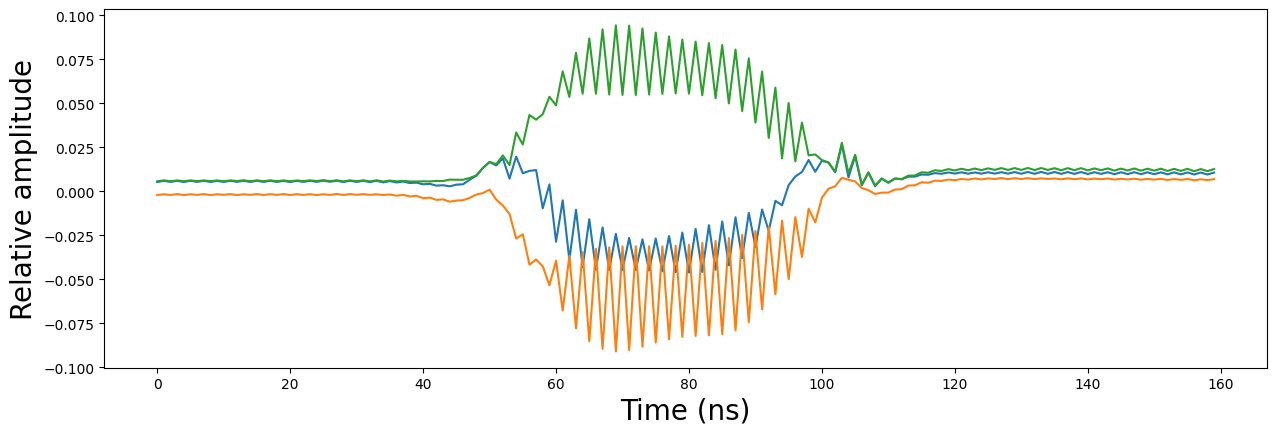
Note that the accumulated acquisitions have already been averaged when the data is returned. The instrument keeps track of the number of accumulations and divides the result upon returning the data. The number of accumulations is also available for review.
[28]:
# Print number of averages
print(avg_acq["avg"]["acquisition"]["scope"]["path0"]["avg_cnt"])
print(avg_acq["avg"]["acquisition"]["scope"]["path1"]["avg_cnt"])
1000
1000
To show that the hardware averaging worked, let’s compare and zoom in on the data from the very first acquisition in this tutorial and the very last.
[29]:
# Plot results
fig, ax = plt.subplots(1, 1, figsize=(15, 15 / 2 / 1.61))
ax.plot(np.array(single_acq["acquisition"]["scope"]["path1"]["data"][100:400]))
ax.plot(np.array(avg_acq["avg"]["acquisition"]["scope"]["path1"]["data"][100:400]))
ax.set_xlabel("Time (ns)", fontsize=20)
ax.set_ylabel("Relative amplitude", fontsize=20)
plt.show()
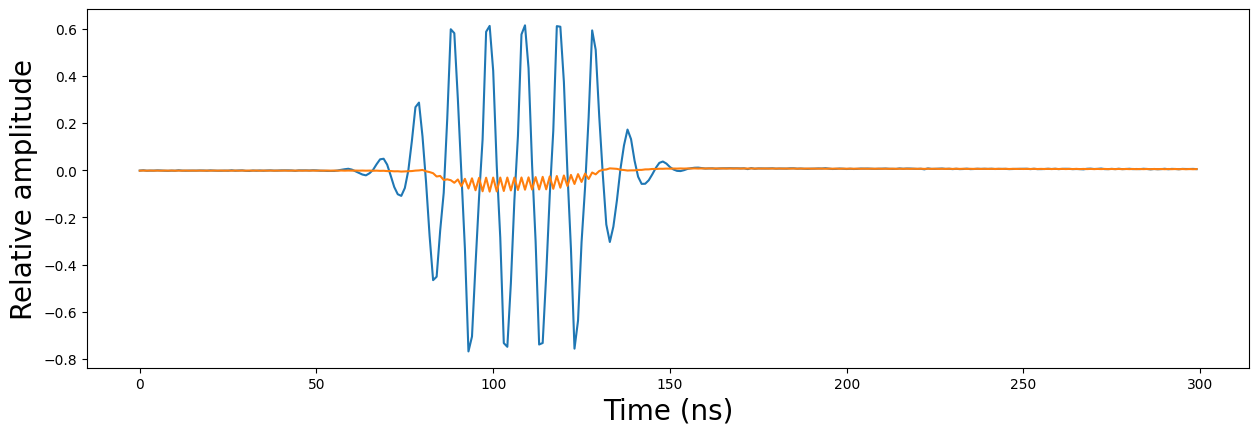
Stop#
Finally, let’s stop the sequencers if they haven’t already and close the instrument connection. One can also display a detailed snapshot containing the instrument parameters before closing the connection by uncommenting the corresponding lines.
[30]:
# Stop sequencer.
readout_module.stop_sequencer()
# Print status of sequencer.
print(readout_module.get_sequencer_status(0))
print()
# Print an overview of the instrument parameters.
print("Snapshot:")
readout_module.print_readable_snapshot(update=True)
# Reset the cluster
cluster.reset()
print(cluster.get_system_status())
Status: STOPPED, Flags: FORCED_STOP, ACQ_SCOPE_DONE_PATH_0, ACQ_SCOPE_DONE_PATH_1, ACQ_BINNING_DONE
Snapshot:
cluster0_module8:
parameter value
--------------------------------------------------------------------------------
in0_att : 0 (dB)
in0_offset_path0 : 0 (V)
in0_offset_path1 : 0 (V)
marker0_inv_en : False
marker1_inv_en : False
out0_att : 0 (dB)
out0_in0_lo_en : True
out0_in0_lo_freq : 3000000000 (Hz)
out0_offset_path0 : 0.5 (mV)
out0_offset_path1 : 0.5 (mV)
present : True
scope_acq_avg_mode_en_path0 : True
scope_acq_avg_mode_en_path1 : True
scope_acq_sequencer_select : 0
scope_acq_trigger_level_path0 : 0
scope_acq_trigger_level_path1 : 0
scope_acq_trigger_mode_path0 : sequencer
scope_acq_trigger_mode_path1 : sequencer
cluster0_module8_sequencer0:
parameter value
--------------------------------------------------------------------------------
connect_acq : in0
connect_out0 : IQ
cont_mode_en_awg_path0 : False
cont_mode_en_awg_path1 : False
cont_mode_waveform_idx_awg_path0 : 0
cont_mode_waveform_idx_awg_path1 : 0
demod_en_acq : True
gain_awg_path0 : 1
gain_awg_path1 : 1
integration_length_acq : 1024
marker_ovr_en : True
marker_ovr_value : 3
mixer_corr_gain_ratio : 0.89999
mixer_corr_phase_offset_degree : -0
mod_en_awg : True
nco_freq : 1e+08 (Hz)
nco_phase_offs : 0 (Degrees)
nco_prop_delay_comp : 0 (ns)
nco_prop_delay_comp_en : True (ns)
offset_awg_path0 : 0
offset_awg_path1 : 0
sync_en : True
thresholded_acq_marker_address : 1
thresholded_acq_marker_en : False
thresholded_acq_marker_invert : False
thresholded_acq_rotation : 0 (Degrees)
thresholded_acq_threshold : 0
thresholded_acq_trigger_address : 1
thresholded_acq_trigger_en : False
thresholded_acq_trigger_invert : False
trigger10_count_threshold : 1
trigger10_threshold_invert : False
trigger11_count_threshold : 1
trigger11_threshold_invert : False
trigger12_count_threshold : 1
trigger12_threshold_invert : False
trigger13_count_threshold : 1
trigger13_threshold_invert : False
trigger14_count_threshold : 1
trigger14_threshold_invert : False
trigger15_count_threshold : 1
trigger15_threshold_invert : False
trigger1_count_threshold : 1
trigger1_threshold_invert : False
trigger2_count_threshold : 1
trigger2_threshold_invert : False
trigger3_count_threshold : 1
trigger3_threshold_invert : False
trigger4_count_threshold : 1
trigger4_threshold_invert : False
trigger5_count_threshold : 1
trigger5_threshold_invert : False
trigger6_count_threshold : 1
trigger6_threshold_invert : False
trigger7_count_threshold : 1
trigger7_threshold_invert : False
trigger8_count_threshold : 1
trigger8_threshold_invert : False
trigger9_count_threshold : 1
trigger9_threshold_invert : False
upsample_rate_awg_path0 : 0
upsample_rate_awg_path1 : 0
cluster0_module8_sequencer1:
parameter value
--------------------------------------------------------------------------------
connect_acq : off
connect_out0 : off
cont_mode_en_awg_path0 : False
cont_mode_en_awg_path1 : False
cont_mode_waveform_idx_awg_path0 : 0
cont_mode_waveform_idx_awg_path1 : 0
demod_en_acq : False
gain_awg_path0 : 1
gain_awg_path1 : 1
integration_length_acq : 1024
marker_ovr_en : False
marker_ovr_value : 0
mixer_corr_gain_ratio : 1
mixer_corr_phase_offset_degree : -0
mod_en_awg : False
nco_freq : 0 (Hz)
nco_phase_offs : 0 (Degrees)
nco_prop_delay_comp : 0 (ns)
nco_prop_delay_comp_en : False (ns)
offset_awg_path0 : 0
offset_awg_path1 : 0
sync_en : False
thresholded_acq_marker_address : 1
thresholded_acq_marker_en : False
thresholded_acq_marker_invert : False
thresholded_acq_rotation : 0 (Degrees)
thresholded_acq_threshold : 0
thresholded_acq_trigger_address : 1
thresholded_acq_trigger_en : False
thresholded_acq_trigger_invert : False
trigger10_count_threshold : 1
trigger10_threshold_invert : False
trigger11_count_threshold : 1
trigger11_threshold_invert : False
trigger12_count_threshold : 1
trigger12_threshold_invert : False
trigger13_count_threshold : 1
trigger13_threshold_invert : False
trigger14_count_threshold : 1
trigger14_threshold_invert : False
trigger15_count_threshold : 1
trigger15_threshold_invert : False
trigger1_count_threshold : 1
trigger1_threshold_invert : False
trigger2_count_threshold : 1
trigger2_threshold_invert : False
trigger3_count_threshold : 1
trigger3_threshold_invert : False
trigger4_count_threshold : 1
trigger4_threshold_invert : False
trigger5_count_threshold : 1
trigger5_threshold_invert : False
trigger6_count_threshold : 1
trigger6_threshold_invert : False
trigger7_count_threshold : 1
trigger7_threshold_invert : False
trigger8_count_threshold : 1
trigger8_threshold_invert : False
trigger9_count_threshold : 1
trigger9_threshold_invert : False
upsample_rate_awg_path0 : 0
upsample_rate_awg_path1 : 0
cluster0_module8_sequencer2:
parameter value
--------------------------------------------------------------------------------
connect_acq : off
connect_out0 : off
cont_mode_en_awg_path0 : False
cont_mode_en_awg_path1 : False
cont_mode_waveform_idx_awg_path0 : 0
cont_mode_waveform_idx_awg_path1 : 0
demod_en_acq : False
gain_awg_path0 : 1
gain_awg_path1 : 1
integration_length_acq : 1024
marker_ovr_en : False
marker_ovr_value : 0
mixer_corr_gain_ratio : 1
mixer_corr_phase_offset_degree : -0
mod_en_awg : False
nco_freq : 0 (Hz)
nco_phase_offs : 0 (Degrees)
nco_prop_delay_comp : 0 (ns)
nco_prop_delay_comp_en : False (ns)
offset_awg_path0 : 0
offset_awg_path1 : 0
sync_en : False
thresholded_acq_marker_address : 1
thresholded_acq_marker_en : False
thresholded_acq_marker_invert : False
thresholded_acq_rotation : 0 (Degrees)
thresholded_acq_threshold : 0
thresholded_acq_trigger_address : 1
thresholded_acq_trigger_en : False
thresholded_acq_trigger_invert : False
trigger10_count_threshold : 1
trigger10_threshold_invert : False
trigger11_count_threshold : 1
trigger11_threshold_invert : False
trigger12_count_threshold : 1
trigger12_threshold_invert : False
trigger13_count_threshold : 1
trigger13_threshold_invert : False
trigger14_count_threshold : 1
trigger14_threshold_invert : False
trigger15_count_threshold : 1
trigger15_threshold_invert : False
trigger1_count_threshold : 1
trigger1_threshold_invert : False
trigger2_count_threshold : 1
trigger2_threshold_invert : False
trigger3_count_threshold : 1
trigger3_threshold_invert : False
trigger4_count_threshold : 1
trigger4_threshold_invert : False
trigger5_count_threshold : 1
trigger5_threshold_invert : False
trigger6_count_threshold : 1
trigger6_threshold_invert : False
trigger7_count_threshold : 1
trigger7_threshold_invert : False
trigger8_count_threshold : 1
trigger8_threshold_invert : False
trigger9_count_threshold : 1
trigger9_threshold_invert : False
upsample_rate_awg_path0 : 0
upsample_rate_awg_path1 : 0
cluster0_module8_sequencer3:
parameter value
--------------------------------------------------------------------------------
connect_acq : off
connect_out0 : off
cont_mode_en_awg_path0 : False
cont_mode_en_awg_path1 : False
cont_mode_waveform_idx_awg_path0 : 0
cont_mode_waveform_idx_awg_path1 : 0
demod_en_acq : False
gain_awg_path0 : 1
gain_awg_path1 : 1
integration_length_acq : 1024
marker_ovr_en : False
marker_ovr_value : 0
mixer_corr_gain_ratio : 1
mixer_corr_phase_offset_degree : -0
mod_en_awg : False
nco_freq : 0 (Hz)
nco_phase_offs : 0 (Degrees)
nco_prop_delay_comp : 0 (ns)
nco_prop_delay_comp_en : False (ns)
offset_awg_path0 : 0
offset_awg_path1 : 0
sync_en : False
thresholded_acq_marker_address : 1
thresholded_acq_marker_en : False
thresholded_acq_marker_invert : False
thresholded_acq_rotation : 0 (Degrees)
thresholded_acq_threshold : 0
thresholded_acq_trigger_address : 1
thresholded_acq_trigger_en : False
thresholded_acq_trigger_invert : False
trigger10_count_threshold : 1
trigger10_threshold_invert : False
trigger11_count_threshold : 1
trigger11_threshold_invert : False
trigger12_count_threshold : 1
trigger12_threshold_invert : False
trigger13_count_threshold : 1
trigger13_threshold_invert : False
trigger14_count_threshold : 1
trigger14_threshold_invert : False
trigger15_count_threshold : 1
trigger15_threshold_invert : False
trigger1_count_threshold : 1
trigger1_threshold_invert : False
trigger2_count_threshold : 1
trigger2_threshold_invert : False
trigger3_count_threshold : 1
trigger3_threshold_invert : False
trigger4_count_threshold : 1
trigger4_threshold_invert : False
trigger5_count_threshold : 1
trigger5_threshold_invert : False
trigger6_count_threshold : 1
trigger6_threshold_invert : False
trigger7_count_threshold : 1
trigger7_threshold_invert : False
trigger8_count_threshold : 1
trigger8_threshold_invert : False
trigger9_count_threshold : 1
trigger9_threshold_invert : False
upsample_rate_awg_path0 : 0
upsample_rate_awg_path1 : 0
cluster0_module8_sequencer4:
parameter value
--------------------------------------------------------------------------------
connect_acq : off
connect_out0 : off
cont_mode_en_awg_path0 : False
cont_mode_en_awg_path1 : False
cont_mode_waveform_idx_awg_path0 : 0
cont_mode_waveform_idx_awg_path1 : 0
demod_en_acq : False
gain_awg_path0 : 1
gain_awg_path1 : 1
integration_length_acq : 1024
marker_ovr_en : False
marker_ovr_value : 0
mixer_corr_gain_ratio : 1
mixer_corr_phase_offset_degree : -0
mod_en_awg : False
nco_freq : 0 (Hz)
nco_phase_offs : 0 (Degrees)
nco_prop_delay_comp : 0 (ns)
nco_prop_delay_comp_en : False (ns)
offset_awg_path0 : 0
offset_awg_path1 : 0
sync_en : False
thresholded_acq_marker_address : 1
thresholded_acq_marker_en : False
thresholded_acq_marker_invert : False
thresholded_acq_rotation : 0 (Degrees)
thresholded_acq_threshold : 0
thresholded_acq_trigger_address : 1
thresholded_acq_trigger_en : False
thresholded_acq_trigger_invert : False
trigger10_count_threshold : 1
trigger10_threshold_invert : False
trigger11_count_threshold : 1
trigger11_threshold_invert : False
trigger12_count_threshold : 1
trigger12_threshold_invert : False
trigger13_count_threshold : 1
trigger13_threshold_invert : False
trigger14_count_threshold : 1
trigger14_threshold_invert : False
trigger15_count_threshold : 1
trigger15_threshold_invert : False
trigger1_count_threshold : 1
trigger1_threshold_invert : False
trigger2_count_threshold : 1
trigger2_threshold_invert : False
trigger3_count_threshold : 1
trigger3_threshold_invert : False
trigger4_count_threshold : 1
trigger4_threshold_invert : False
trigger5_count_threshold : 1
trigger5_threshold_invert : False
trigger6_count_threshold : 1
trigger6_threshold_invert : False
trigger7_count_threshold : 1
trigger7_threshold_invert : False
trigger8_count_threshold : 1
trigger8_threshold_invert : False
trigger9_count_threshold : 1
trigger9_threshold_invert : False
upsample_rate_awg_path0 : 0
upsample_rate_awg_path1 : 0
cluster0_module8_sequencer5:
parameter value
--------------------------------------------------------------------------------
connect_acq : off
connect_out0 : off
cont_mode_en_awg_path0 : False
cont_mode_en_awg_path1 : False
cont_mode_waveform_idx_awg_path0 : 0
cont_mode_waveform_idx_awg_path1 : 0
demod_en_acq : False
gain_awg_path0 : 1
gain_awg_path1 : 1
integration_length_acq : 1024
marker_ovr_en : False
marker_ovr_value : 0
mixer_corr_gain_ratio : 1
mixer_corr_phase_offset_degree : -0
mod_en_awg : False
nco_freq : 0 (Hz)
nco_phase_offs : 0 (Degrees)
nco_prop_delay_comp : 0 (ns)
nco_prop_delay_comp_en : False (ns)
offset_awg_path0 : 0
offset_awg_path1 : 0
sync_en : False
thresholded_acq_marker_address : 1
thresholded_acq_marker_en : False
thresholded_acq_marker_invert : False
thresholded_acq_rotation : 0 (Degrees)
thresholded_acq_threshold : 0
thresholded_acq_trigger_address : 1
thresholded_acq_trigger_en : False
thresholded_acq_trigger_invert : False
trigger10_count_threshold : 1
trigger10_threshold_invert : False
trigger11_count_threshold : 1
trigger11_threshold_invert : False
trigger12_count_threshold : 1
trigger12_threshold_invert : False
trigger13_count_threshold : 1
trigger13_threshold_invert : False
trigger14_count_threshold : 1
trigger14_threshold_invert : False
trigger15_count_threshold : 1
trigger15_threshold_invert : False
trigger1_count_threshold : 1
trigger1_threshold_invert : False
trigger2_count_threshold : 1
trigger2_threshold_invert : False
trigger3_count_threshold : 1
trigger3_threshold_invert : False
trigger4_count_threshold : 1
trigger4_threshold_invert : False
trigger5_count_threshold : 1
trigger5_threshold_invert : False
trigger6_count_threshold : 1
trigger6_threshold_invert : False
trigger7_count_threshold : 1
trigger7_threshold_invert : False
trigger8_count_threshold : 1
trigger8_threshold_invert : False
trigger9_count_threshold : 1
trigger9_threshold_invert : False
upsample_rate_awg_path0 : 0
upsample_rate_awg_path1 : 0
Status: OKAY, Flags: NONE, Slot flags: NONE
c:\work\code\qblox_instruments_install\qblox_instruments\native\generic_func.py:1033: FutureWarning:
After June 2024, this feature is subject to removal in future releases.
Transition to an alternative is advised.
See https://qblox-qblox-instruments.readthedocs-hosted.com/en/main/getting_started/deprecated.html
warnings.warn(